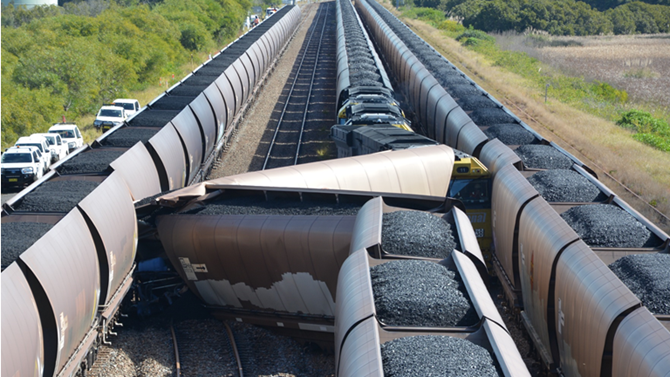Newcastle Low-Light Collision Results in Changes of Procedure & Risk Control

A loaded coal train collided with the rear of a stationary train in low-light conditions at the Port of Newcastle, after network control was not advised that the second train was disabled, an ATSB (Australian Transport Safety Bureau) investigation report notes.
Just after 5 am on July 29, 2020, a loaded Pacific National (PN) coal train collided at 16 km/h with the rear of a stationary One Rail Australia (ORA) coal train in low-light conditions, when arriving at Kooragang Coal Terminal, in Newcastle, NSW.
The PN locomotive and the two rearmost wagons of the ORA train derailed in the collision, and came into contact with two adjacent stationary trains, which sustained minor damage.
One of the PN drivers sustained minor injuries, and there was substantial damage to the rail infrastructure.
An investigation into the incident was undertaken by the Office of Transport Safety Investigations (OTSI), which conducts rail safety investigations in NSW on behalf of the Australian Transport Safety Bureau.
The investigation found that while the ORA train was unloading several penalty brake applications associated with a fault in its electronic pneumatic brake system had disabled the train, bringing it to a standstill.
The crew investigated the faults using a series of technical exercises, which caused the train’s End of Train light to be extinguished — creating the low-light conditions.
“This disablement of the ORA train constituted a Condition Affecting the Network, but the crew did not report this to the Kooragang Network Controller as they were required to do,” OTSI Chief Investigator Dr Natalie Pelham explained.
“Subsequently, the Kooragang Network Controller set a signal for the PN train to proceed with caution along the arrival road where the ORA train was stationary.”
The terminal area where the accident occurred was poorly lit by artificial trackside lighting — creating low-light conditions— and the absence of an End of Train light at the rear of the stationary train reduced its conspicuity, Dr Pelham explained.
“Light produced by an overhead gantry, above the accident site, may also have caused disabling glare for the drivers of the PN train,” she added.
Since the collision, PN issued notices informing drivers to not exceed 8 km/h upon receiving a shunt proceed signal within Kooragang terminal.
ORA has added programmed monitoring of End of Train lights into its asset management plan, and circulated safety information to their drivers to remind them of the requirement to communicate all conditions affecting the network to network control.
The Australian Rail Track Corporation (ARTC) provided clarification advice to rail operators on the operation of trains with defective EOT lights and updated information contained in the Rail Access Standard (general information). ARTC also plans to review the Kooragang Operations Protocol and conduct a risk assessment to ensure the risk of collision is effectively managed and controlled during operations.
“This accident highlights the importance of train crews communicating conditions affecting the network to network control,” Dr Pelham said.
“It also emphasises the need for train crews operating in areas of restricted visibility to be prepared to stop short of any obstruction on the track.”
Key points
- Loaded coal train collided with the rear of a second, stationary coal train at Kooragang Coal Terminal;
- Stationary train had stopped due to technical issues, but its crew failed to notify train control;
- Operators of both trains and the track manager have taken safety actions as a result.
Source: ATSB; read the ATSB report: RO-2020-013: Collision between coal trains MB526 and AH378, Kooragang, New South Wales, on 29 July 2020.
Attend the best conference for smart workers and safe clients: The 2022 Global TapRooT® Summit
There’s a good reason why, since 1994, hundreds of companies make it a priority to send experts and /teams to the Global TapRooT® Summit: The attendees bring back unique training, strategies, and tips on how their companies can improve performance while keeping their record clean and their employees and clients working safe and all on the same page. You should, too.
In 1994, we started the TapRooT® Summit as a three-day meeting of the best TapRooT® users. The Summit has grown into an international event with world-renowned sessions and keynote speakers and multiple tracks designed to share performance improvement best practices across industries and professions.
We are pleased to present our 2022 Global TapRooT® Summit Keynote Speakers:
- Inky Johnson, “The Process: Trust It. Respect It. Embrace It.”
- Ken Futch, “Take Your Best Shot!”
- Claus Rose, “What Senior Managers Want from Root Cause Analysis”
- Admiral Joseph Aucoin, “Hearing warnings: The need for senior leadership to listen and respond to signals that indicate unacceptable risk.”
- Kirstie Ennis, “Don’t Accept Limitations.”

This year, come to beautiful East Tennessee for the best conference you can attend. We’ll be in Knoxville, Tennessee, May 2-6, listening and learning from the best of the best:
- Pre-Summit courses (May 2-3, prior to the Wednesday kickoff and first day of the Summit)
- Keynote speakers
- Networking opportunities
- Best practices sessions
Learn more about what your team(s) will be doing at the TapRooT® Summit from the brochure and the Summit schedule.
Register now for the 2022 Global TapRooT® Summit and bring your team. You’ll be glad you did.



